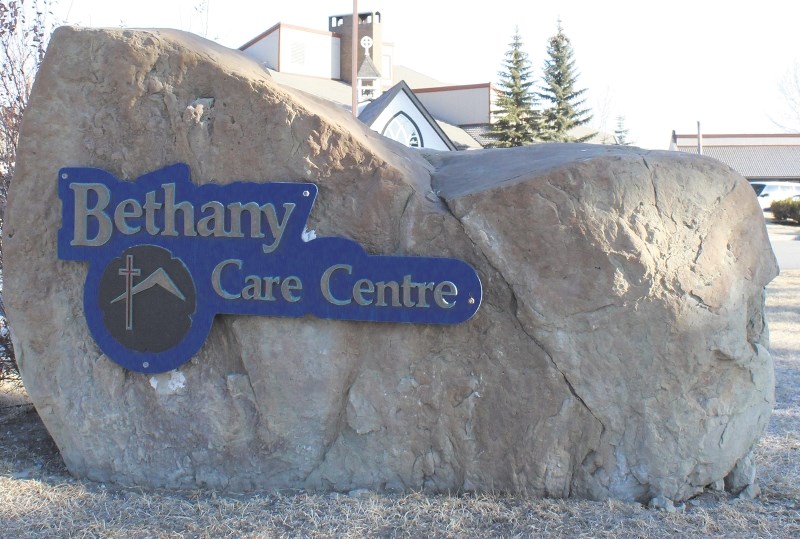Family members of Cochrane’s Bethany Care Centre did not mix words voicing their displeasure with Alberta Health Services’ (AHS) new funding model, one that has seen the long-term care facility lose money and staff.
During an April 16 meeting at the Bethany Centre, approximately 60 came to hear what president and CEO of the Bethany Care Society. Greer Black, had to say about the cutbacks.
“It’s a perverse system,” Black said, also not mixing words, of the new model.
Black said AHS’ new funding model does not work well for those living with dementia or other mental health issues, and does not help them live independent lives, an effort Bethany facilities strive for.
The funding model released by AHS is intended to assesses each resident’s level of care and assign a funding value based on where the resident’s care needs rank against a provincial average.
These funding values are weighed more heavily for residents with complex care needs and rehabilitation-focused care.
Black said the new model does not align with Bethany’s model.
“We’ve been very much a social model,” said Black. “A place where people live first. (AHS) funding is pushing the therapeutic side…we’re going back to where we were 10 years ago.”
Black said other provinces are moving in the opposite direction of Alberta, focusing on the social side of care rather than therapeutic.
In the new model, AHS therapy rates higher (accumulating more points) than care for those with dementia, and results in more funding and more staff.
Facilities that provide more rehabilitation will end up receiving more funding.
Because there is no rehabilitation for dementia patients, Bethany will not acquire as many points, and in turn, lose money.
Currently, 80 per cent of Bethany residents live with dementia.
The effect this new model will have on staff levels is a major concern for many who have loved ones in Bethany.
“Less staff means longer times in wet, soiled diapers,” said one of these concerned people, who did not want to be identified for fear of repercussions. “Add to this the many other care needs for approximately 75 residents in long-term care and you quickly get the picture of why more staff is needed, not decreased funding, which results in staff reductions.”
AHS’ model dictates a particular schedule for Bethany to follow; if it does not, the facility will lose more funding.
Staffing requirements are as follows: 15.71 per cent to registered nurses (RN); 11.18 per cent to licensed practical nurses (LPN); 62.86 per cent for health-care aids (HCA); 5.44 per cent to professional therapists; and 4.83 per cent for other therapists.
At all times, a minimum of one RN and two other care workers must be on site.
Black indicated that salaries and benefits make up about 75 per cent of Bethany’s overall costs, and that the number was a normal comparison across the country.
For the Cochrane location, this staffing model means losing 8.5 full-time equivalent positions, primarily hitting LPNs, HCAs and recreational assistants.
LPNs and HCAs do much of the legwork in long-term care facilities, such as lifting, cleaning and moving patients. Some present at the April 16 meeting felt that RNs would need to do more to alleviate the loss of LPN and HCA staff hours.
“These changes have been difficult for everyone,” said Doreen Wilson, administrator for Bethany Cochrane. “We’re trying our best to provide the same care as we can.”
Wilson did indicate that Bethany Cochrane would hire 1.5 full-time equivalent RN positions.
Wilson said many of those who have been laid off as a result of the new model remain part of an on-call pool, picking up shifts when they can.
This, however, raised some eyebrows during the meeting, as some look to hire private help in order to pick up the slack created by this new model, but are unable to do so because of a Bethany policy that anyone employed by the care facility cannot accept additional work on a private basis.
Hearing the concerns, Black said he would review that policy and perhaps make a change, but needed to first assess any conflict of interest that may arise from such a move.
As for how to deal with the new reality, Black suggested that those who had concerns should write a letter to Alberta’s minister of health, Fred Horne, or start a petition.
“I hate to see someone coming from the outside and change things,” Black said, declaring that those living with dementia should be ‘high priority.’
“Bethany is caught between a rock and a hard place and is doing its best to work within the moneys allocated to them by AHS,” said the anonymous source. “Yet just accepting it without a fight means that there is no hope for a reconsideration by AHS.
“Some of these residents in long-term care fought in the Second World War for our freedoms. They are the ones who lived through depression years and raised families and built Alberta. Is this their payback?”
Bethany Care provides care for 800 long-term care residents at six locations in central and southern Alberta.
To learn more about AHS’ new funding model visit albertahealthservices.ca/7880.asp.




